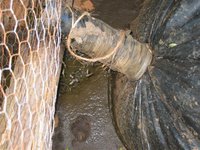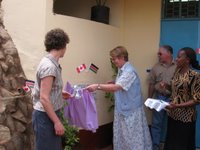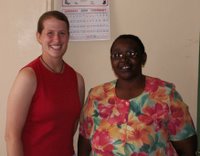Biogas Generator
Submitted by Ken Mellish
February 18, 2006
 It is seldom that you see a low cost item that works better than the more expensive unit. We saw that in a plastic tube biogas generator.
It is seldom that you see a low cost item that works better than the more expensive unit. We saw that in a plastic tube biogas generator.
While we were visiting farms in the Embu district of Kenya we saw a biogas generator demonstration. The demonstration was done by KARI, the Kenyan Agricultural Research Institute, and was on the farm of Mrs Geru. We have seen biogas units made from concrete with a floating steel cover in several tropical countries. I understand the plastic tube method of making biogas was developed in South America.
This unit was made from a 10 meter length of plastic silage tubing, two pieces of sewer pipe and an outlet pipe to collect the biogas.
 The plastic tube is laid on a 5 degree slope and protected from animals with a fence. The tube is partially filled with a mix of 2 water to 1 cow manure and then each day a 20 liter bucket of cow manure is mixed with two buckets of water and poured into the unit through the sewer pipe. The result is three buckets of wet compost and enough biogas to cook the meals for the household. The pipe with a simple valve on it goes to a gas ring in the kitchen. The flame burns hot and clean. The black plastic tube gets hot in the sun which will speed up the digestion process making it more efficient than the concrete-steel unit.
The plastic tube is laid on a 5 degree slope and protected from animals with a fence. The tube is partially filled with a mix of 2 water to 1 cow manure and then each day a 20 liter bucket of cow manure is mixed with two buckets of water and poured into the unit through the sewer pipe. The result is three buckets of wet compost and enough biogas to cook the meals for the household. The pipe with a simple valve on it goes to a gas ring in the kitchen. The flame burns hot and clean. The black plastic tube gets hot in the sun which will speed up the digestion process making it more efficient than the concrete-steel unit.

This unit:
- was low cost;
- simple to make of locally available materials;
- saved on purchased fuels;
- replaced firewood;
- produced finished compost for fertilizer and
- easy to use.
February 18, 2006
 It is seldom that you see a low cost item that works better than the more expensive unit. We saw that in a plastic tube biogas generator.
It is seldom that you see a low cost item that works better than the more expensive unit. We saw that in a plastic tube biogas generator.While we were visiting farms in the Embu district of Kenya we saw a biogas generator demonstration. The demonstration was done by KARI, the Kenyan Agricultural Research Institute, and was on the farm of Mrs Geru. We have seen biogas units made from concrete with a floating steel cover in several tropical countries. I understand the plastic tube method of making biogas was developed in South America.
This unit was made from a 10 meter length of plastic silage tubing, two pieces of sewer pipe and an outlet pipe to collect the biogas.
 The plastic tube is laid on a 5 degree slope and protected from animals with a fence. The tube is partially filled with a mix of 2 water to 1 cow manure and then each day a 20 liter bucket of cow manure is mixed with two buckets of water and poured into the unit through the sewer pipe. The result is three buckets of wet compost and enough biogas to cook the meals for the household. The pipe with a simple valve on it goes to a gas ring in the kitchen. The flame burns hot and clean. The black plastic tube gets hot in the sun which will speed up the digestion process making it more efficient than the concrete-steel unit.
The plastic tube is laid on a 5 degree slope and protected from animals with a fence. The tube is partially filled with a mix of 2 water to 1 cow manure and then each day a 20 liter bucket of cow manure is mixed with two buckets of water and poured into the unit through the sewer pipe. The result is three buckets of wet compost and enough biogas to cook the meals for the household. The pipe with a simple valve on it goes to a gas ring in the kitchen. The flame burns hot and clean. The black plastic tube gets hot in the sun which will speed up the digestion process making it more efficient than the concrete-steel unit.
This unit:
- was low cost;
- simple to make of locally available materials;
- saved on purchased fuels;
- replaced firewood;
- produced finished compost for fertilizer and
- easy to use.





